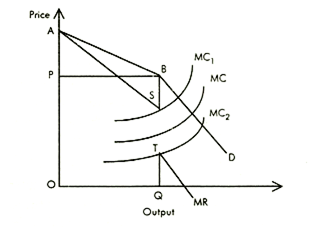Price Rigidity: The Kinked Demand Model
In the 1930s, Paul Sweezy developed a kinked demand curve model to explain price rigidity. The basic assumption of the model is that competitors will follow a price decrease but will not make a change if price increases. Consider a typical oligopolist who is charging price P at the point of the kink (point B) on the demand curve ABD in Fig. 7.10. Sweezy argued that if one firm raised its price above P, other firms will not follow the increase. The rival firms can acquire market share by holding to their present prices. The firm that increases price will lose considerable amount of sales. In short, the demand is elastic for price increase. This explains the elastic portion (AB) of the demand curve.
Conversely, if the firm lowers the price below P, other firms may follow to maintain their market shares. As a result, the price cut by the original firm will not add much to its sales. Therefore, for price reductions the demand is relatively inelastic (BD). This explains the kink in the demand curve at the firms' current price.
Associated with the demand curve is a MR curve. The kinked demand curve consists of two linear MR curves. The left part of the MR curve corresponds to the prices above the kink (elastic demand curve AB) and lower curve for prices below the kink. At the point of kink, the MR curve is discontinuous or has a gap ST.
In view of the kinked demand curve, the firm's profit maximising price and quantity are P and Q where MR = MC This is easily confirmed by noting that the firm's demand curve is discontinuous. The presence of the vertical discontinuity in MR means that P and Q are optimal so long as the firm's MC curve intersects the MR within the gap. An increase in the marginal cost (Me1) due to higher input prices or a decrease (MC2) due to lower input prices or efficient production techniques within the gap (ST) result in no change in the profit maximising price and output. Small changes in the demand that retain the kink at price P would leave the firm's optimal price unchanged. In short, each firm's price remains constant over a range of changing market conditions. The result is stable industry-wide prices.

Some economists have challenged the kinked demand curve model. Stigler observed several oligopolistic industries and found little evidence or empirical support for Sweezy's model. Further, the model does not explain how the price is originally set at the kink Therefore it is incomplete. Nor does it justify the price cutting behaviour of rivals (for example, a rival may prefer to hold to its price and sacrifice market share rather than cut price and profit margins). A complete model needs to incorporate a richer treatment of strategic behaviour. However, the significance of kinked demand curve model lies in the explanation of the price rigidity in some oligopolistic markets, despite change in demand and cost conditions.
Managerial Economics Tutoring - Assignment Help
Our online managerial economics experts are here for your help. Expertsmind.com online assignment help-homework help brings you high grade in your courses and examination, We at Expertsmind.com offers managerial economics assignment help, managerial economics homework help and projects help. We offer complete package of managerial economics online tutoring for 24x7 hours.
ExpertsMind.com - Kinked Demand Model Assignment Help, Kinked Demand Model Homework Help, Kinked Demand Model Assignment Tutors, Kinked Demand Model Solutions, Kinked Demand Model Answers, Sources of Oligopoly Assignment Tutors